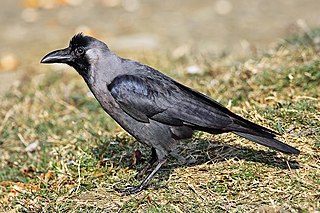
The house crow, also known as the Indian, greynecked, Ceylon or Colombo crow, is a common bird of the crow family that is of Asian origin but now found in many parts of the world, where they arrived assisted by shipping. It is between the jackdaw and the carrion crow in size but is slimmer than either. The forehead, crown, throat and upper breast are a richly glossed black, whilst the neck and breast are a lighter grey-brown in colour. The wings, tail and legs are black. There are regional variations in the thickness of the bill and the depth of colour in areas of the plumage.

Fouquieria splendens is a plant indigenous to the Sonoran Desert and Chihuahuan Desert in the Southwestern United States, and northern Mexico.

Charles Tate Regan FRS was a British ichthyologist, working mainly around the beginning of the 20th century. He did extensive work on fish classification schemes.

Toxorhynchites, also called elephant mosquito or mosquito eater, is a genus of diurnal and often relatively colorful mosquitoes, found worldwide between about 35° north and 35° south. It includes the largest known species of mosquito, at up to 18 mm (0.71 in) in length and 24 mm (0.94 in) in wingspan. It is among the many kinds of mosquito that do not consume blood. The adults subsist on carbohydrate-rich materials, such as honeydew, or saps and juices from damaged plants, refuse, fruit, and nectar.
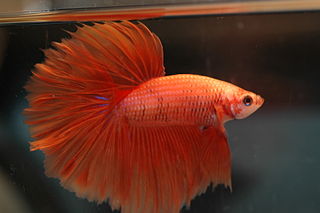
The Siamese fighting fish, also known as the betta, is a popular fish in the aquarium trade. Bettas are a member of the gourami family and are known to be highly territorial. Males in particular are prone to high levels of aggression and will attack each other if housed in the same tank. If there is no means of escape, this will usually result in the death of one or both of the fish. Female bettas can also become territorial towards each other if they are housed in too small an aquarium. It is typically not recommended to keep male and female bettas together, except temporarily for breeding purposes which should always be undertaken with caution.

Euphorbia milii, the crown of thorns, Christ plant, or Christ thorn, called Corona de Cristo in Latin America, is a species of flowering plant in the spurge family Euphorbiaciae, native to Madagascar. The species name commemorates Baron Milius, once Governor of Réunion, who introduced the species to France in 1821. It is imagined that the species was introduced to the Middle East in ancient times, and legend associates it with the crown of thorns worn by Christ.
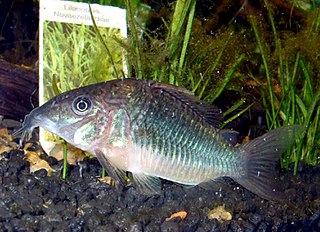
The emerald catfish is a tropical freshwater fish belonging to the Corydoradinae sub-family of the family Callichthyidae native to the Amazon Basin in South America. It has traditionally been known as Brochis splendens. The fish has appeared on a stamp in Brazil.
Opsaridium splendens is a species of ray-finned fish in the family Cyprinidae found in Burundi and Tanzania. Its natural habitat is rivers. It is threatened by habitat loss.

Tachyoryctes is a genus of rodent in the family Spalacidae. It contains the following species:
Aphanius splendens, the Gölçük toothcarp or splendid killifish, is an extinct species of freshwater fish in the family Cyprinodontidae. It was endemic to Lake Gölçük in Turkey. It became extinct due to the effects of fish introduced to the lake.
Leptolebias splendens, also known as the Splendid pearlfish is a species of killifish in the family Rivulidae endemic to Brazil, in the vicinity of Rio de Janeiro. This species was described as Cynolebias splendens in 1942 by George S. Myers with the type locality given as water holes or ponds along the foot of the Serra de Petropolis in Rio de Janeiro State. Deforestation and urbanisation led to the species disappearance from the area of its type locality and it was thought to be extinct but it was rediscovered 5 kilometres (3.1 mi) from the type locality some 70 years after the last known previous record.
Neolamprologus splendens is a species of cichlid endemic to Lake Tanganyika where it is only known to occur around Cape Zongwe in the Democratic Republic of the Congo. This species can reach a length of 8 centimetres (3.1 in) TL.
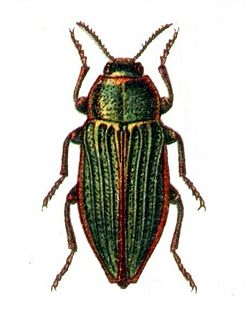
The Goldstreifiger is a species of beetle in the family Buprestidae. It has a wide but scattered distribution from Western Europe to Russia; it is now extinct in Germany, Austria and probably Ukraine; it survives at three localities in Spain, two localities in Basilicata (Italy), Russia, Poland, southwestern Romania, Bosnia and Herzegovina, Albania and possibly Greece. It lives in sun-exposed Pinus forest, and is threatened with extinction by logging. This species is listed on Appendix II of the Bern Convention and Annex II and IV of the EU Habitats Directive.
Licania splendens is a tree in the family Chrysobalanaceae. The specific epithet splendens is from the Latin meaning "shining", referring to surfaces of the dried leaves.

Hylocomium splendens, commonly known as glittering woodmoss, splendid feather moss, stairstep moss, and mountain fern moss, is a perennial clonal moss with a widespread distribution in Northern Hemisphere boreal forests. It is commonly found in Europe, Russia, Alaska and Canada, where it is often the most abundant moss species. It also grows in the Arctic tundra and further south at higher elevations in, for example, northern California, western Sichuan, East Africa, Australia, New Zealand and the West Indies. In Scotland it is a characteristic species of the Caledonian Forest. Under the UK's national vegetation classification system, pinewood community W18 is named as "Pinus sylvestris-Hylocomium splendens woodland", indicating its significance in this ecosystem.

Betta, is a large genus of small, often colorful, freshwater ray-finned fishes, known as "bettas", in the gourami family (Osphronemidae). The best known Betta species is B. splendens, commonly known as the Siamese fighting fish.

Conognatha is a genus of beetles in the family Buprestidae, containing the following species: They are found in the Neotropical ecozone.
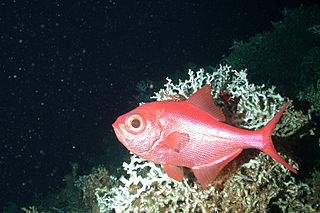
Beryx is a genus of alfonsinos found in deep oceanic waters. Two of its member species, B. decadactylus and B. splendens, are found across nearly the entire globe and are of some commercial importance.

Conognatha pretiosissima is a species of beetles in the family Buprestidae.
The banded ground gecko is a gecko endemic to Japan.















